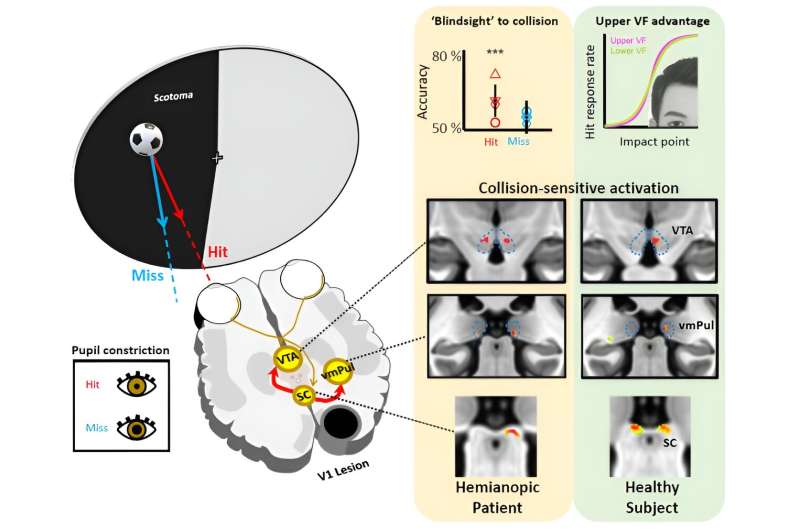The human subcortical pathway detects collision trajectories in unawareness condition. Credit: Zhang Peng's group
A research team has revealed the human subcortical neural pathway underlying the automatic detection of collision trajectories, even in the absence of attention and awareness. The work was published in PLOS Biology.
Using healthy human adults and hemianopic patients as experimental subjects, the researchers, led by Prof. Zhang Peng and Prof. He Sheng from the Institute of Biophysics of the Chinese Academy of Sciences and Prof. Wang Dajing from the Third Medical Center of PLA General Hospital, combined behavioral experiments, eye-tracking, and high-resolution 7T functional magnetic resonance imaging (fMRI) to investigate the neural mechanisms of collision trajectory detection.
The behavioral experiments showed that healthy participants were able to accurately distinguish between collision and non-collision trajectories, and their pupil size was reduced for collision events. High-resolution fMRI revealed that subcortical pathways from the superior colliculus to the ventromedial pulvinar and ventral tegmental area can automatically detect collision trajectories even without attention.
Compared to the lower visual field, both behavioral performance, pupil size changes and subcortical responses were more sensitive to collision trajectories from the upper visual field. These findings suggest that human subcortical pathways may be optimized and specialized for detecting transient and biologically salient information in the upper visual field.
When visual stimuli were presented in the blind visual field of hemianopic patients, even without subjective awareness of the visual stimuli, their subcortical pathways showed significant activation to the collision trajectory. Subcortical responses also predicted the behavioral performance in collision detection.
This study has revealed the neural basis for "blindsight" in detecting visual threats and provides theoretical support for optimizing computer vision algorithms for collision detection.
More information: Fanhua Guo et al, Human subcortical pathways automatically detect collision trajectory without attention and awareness, PLOS Biology (2024). DOI: 10.1371/journal.pbio.3002375
Provided by Chinese Academy of Sciences























